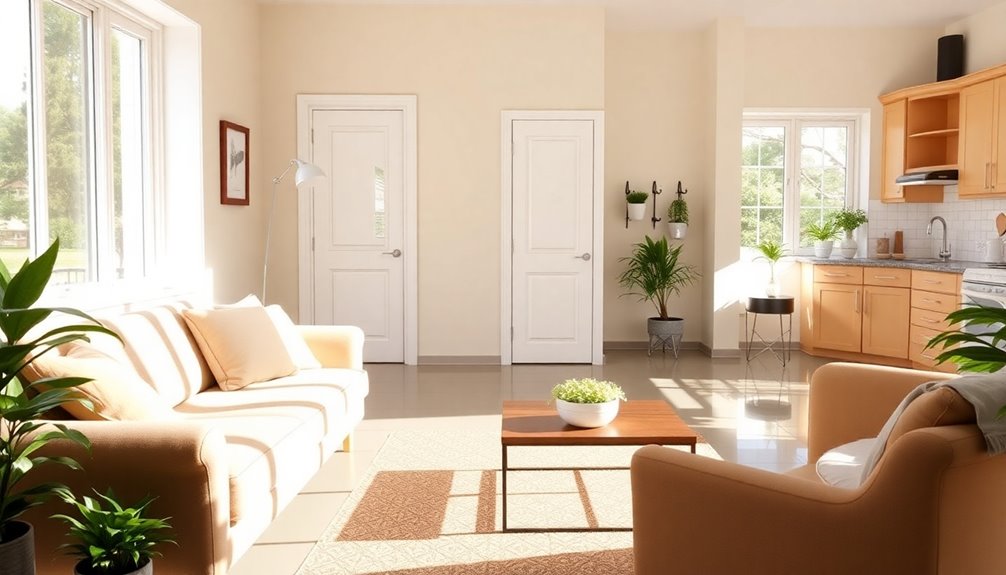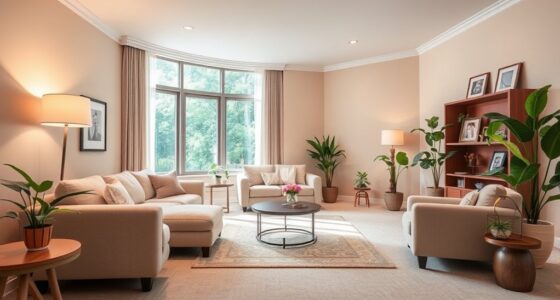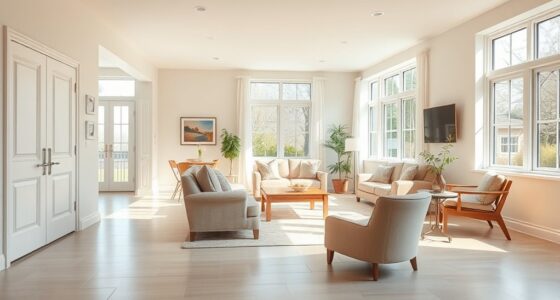To create an ideal senior home, focus on universal design principles. Install curbless showers and grab bars for safety in bathrooms. Use lever handles on doors and cabinets for easy access. Minimize stair climbing by adding ramps or stair lifts. In bedrooms, guarantee there's ample clearance around furniture. Incorporate smart lighting for convenience, and make kitchens accessible. These modifications promote independence and comfort. Keep going to discover more valuable tips for enhancing your space!
Key Takeaways
- Install curbless showers and slip-resistant flooring to enhance safety and prevent falls in bathrooms.
- Use lever-style handles for doors and cabinets to simplify operation for individuals with limited hand strength.
- Incorporate ramps and stair lifts to ensure easy mobility throughout the home, reducing fall risks.
- Design bedrooms with lower bed mattresses and ample maneuvering space to promote comfort and independence.
- Regularly inspect safety features and maintain cleanliness to support both physical safety and mental well-being.
Universal Design Ideas for Bathrooms
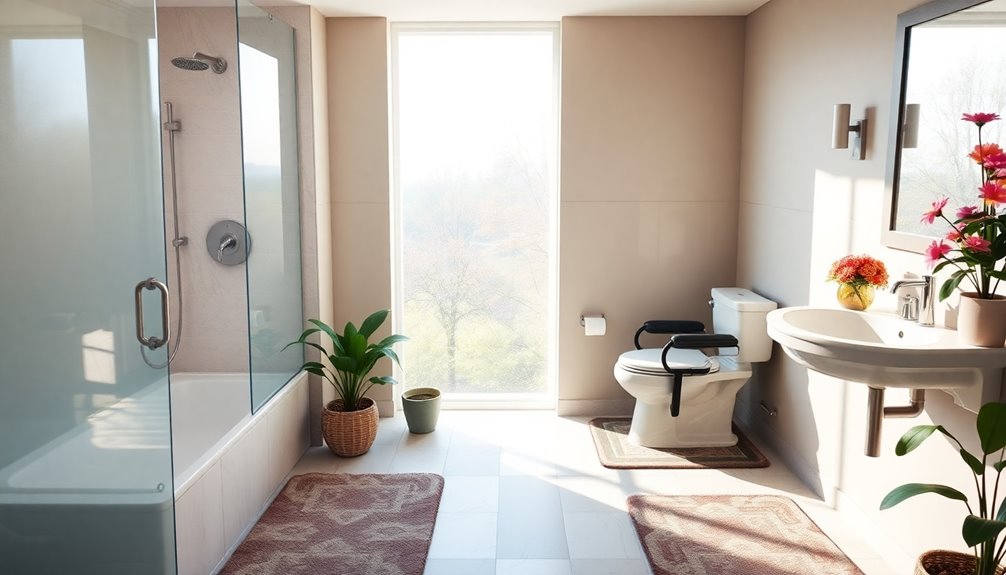
When designing a bathroom for seniors, you'll want to prioritize accessibility and safety.
Start by considering a curbless shower, which eliminates trip hazards and allows for easy entry. Installing grab bars at 33 to 35 inches above the ground can greatly enhance safety when using toilets, showers, and bathtubs.
To prevent slips and falls, don't forget to add slip-proof mats on tiled floors. You might also want to install showerheads at lower heights for easier access.
For a safer bathing experience, walk-in bathtubs provide an excellent option, allowing seniors to enter without stepping over high sides.
These adjustments can create a functional and secure environment, making daily routines much more manageable. Additionally, incorporating senior safety measures can further enhance the overall security of the bathroom space.
Add Handles to All Doors and Cabinets
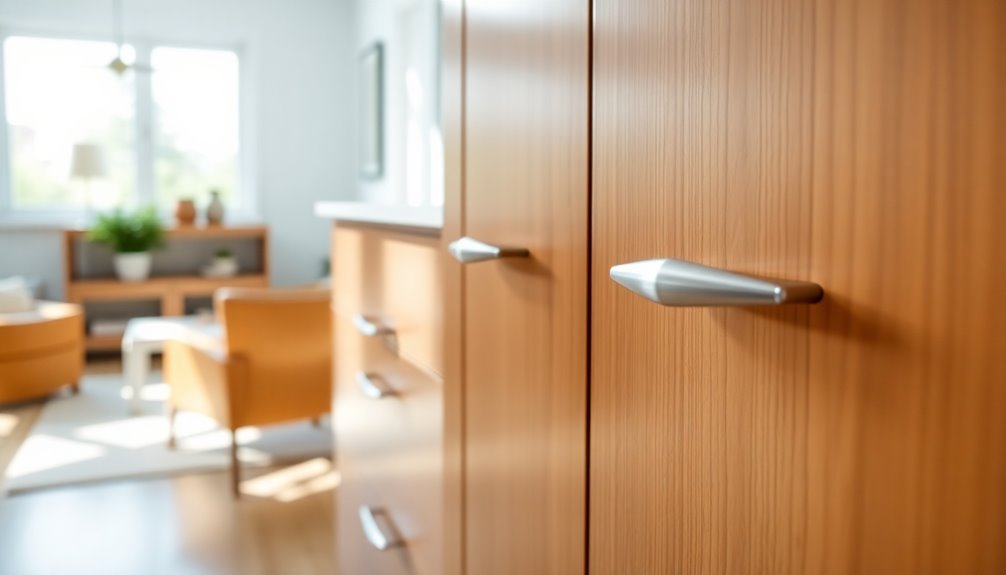
Adding handles to all doors and cabinets can greatly enhance accessibility for seniors. Simple handles allow for easy opening with a single grab or push, making daily tasks more manageable. Consider lever-style handles over traditional doorknobs, as they're easier to grip. You might also explore handleless designs with motion sensors for a modern touch. Consistency in handle design across your home promotes usability, while positioning them at a comfortable height—between 30 to 48 inches—ensures accessibility for aging individuals.
| Type of Handle | Benefits | Recommended Height |
|---|---|---|
| Lever-style | Easy grip and operation | 30-48 inches |
| Simple handles | One-handed use | 30-48 inches |
| Motion sensor | No physical contact needed | 30-48 inches |
Minimize Stair Climbing
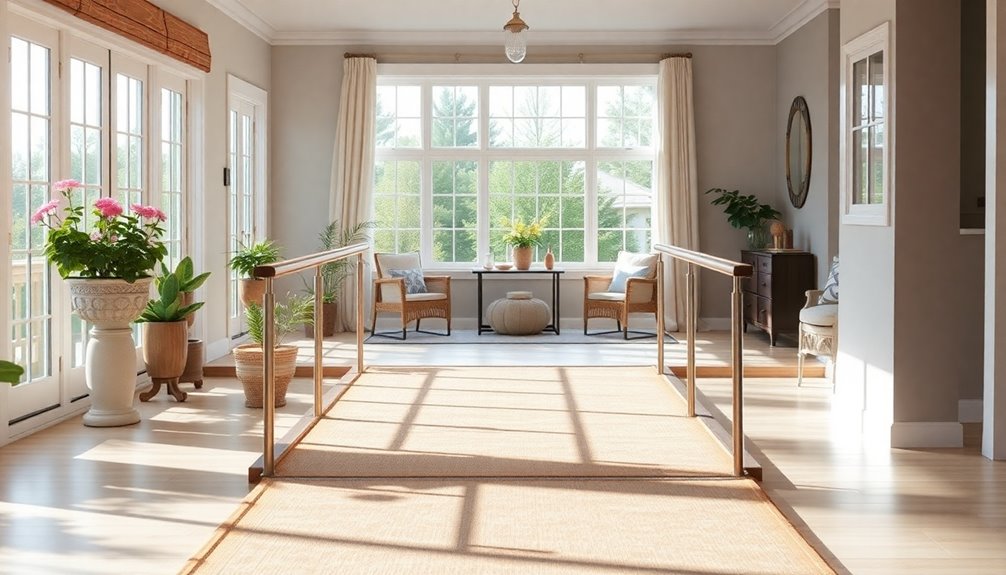
To enhance safety and independence for seniors, minimizing stair climbing is essential. By focusing on home accessibility, you can create a safe and comfortable environment.
Consider installing ramps instead of stairs, which can cost between $1,061 and $3,406 based on materials. For those who can walk but struggle with stairs, a stair lift is a practical solution, with installation costs ranging from $2,300 to $24,000.
If mobility devices are needed, home elevators provide an ideal option, costing between $4,000 and over $30,000. Ensuring that all living spaces are accessible on one level reduces the risk of falls and injuries. Implementing universal design principles ensures that homes are tailored to meet the needs of all users, regardless of age or ability.
Incorporating these Universal Design features can greatly improve the quality of life for seniors in your home. By ensuring that spaces are accessible and easy to navigate, you can help prevent accidents and promote independence. Additionally, embracing universal design in home decor not only enhances functionality but also creates a welcoming and aesthetically pleasing environment for everyone. Ultimately, these thoughtful modifications allow seniors to maintain their dignity and comfort as they age in place.
Wheelchair-accessible Bedroom
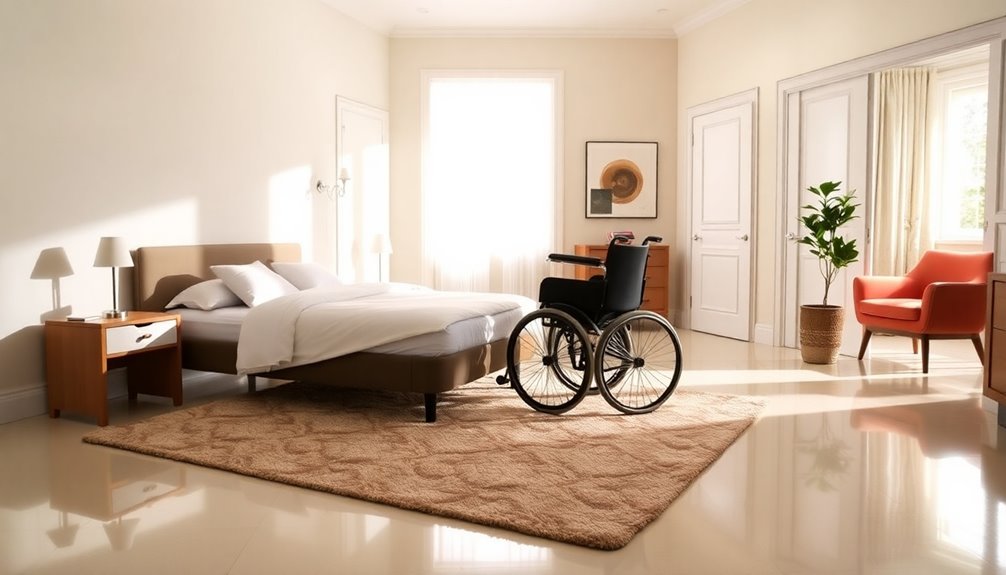
Creating a wheelchair-accessible bedroom involves thoughtful design that prioritizes comfort and independence. To improve accessibility, consider the following features:
| Feature | Description | Benefits |
|---|---|---|
| Lower Bed Mattress | Positioned at waist level for easy access | Facilitates transfer for individuals with disabilities |
| Lowered Shelving | Accessible from a seated position | Keeps essentials within reach |
| Low-Pile Carpet | Minimum quarter-inch padding | Enhances safety, reduces slips |
| Ample Clearance | 30-by-48 inches around furniture | Allows for easy maneuverability |
Incorporating low-pile carpet can enhance safety and reduce slips, which is crucial in a senior-friendly environment.
Leave Enough Clearance
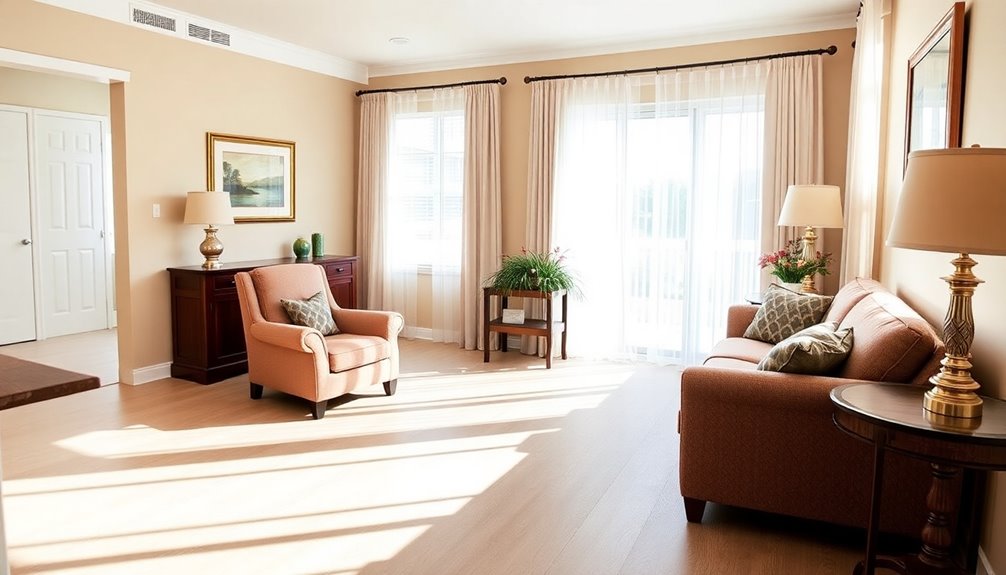
Ensuring at least 30-by-48 inches of clearance around furniture and appliances is essential for wheelchair maneuverability in senior homes.
You should also aim for aisles, doorways, and hallways that are at least 42 to 48 inches wide. This width not only boosts accessibility but also prevents congestion in high-traffic areas, making daily activities safer and easier.
Conducting aging in place home inspections can help you evaluate and optimize clearance throughout your living space. If you notice tight spots, don't hesitate to reposition furniture as needed.
Creating this open space improves mobility and fosters a safer environment for seniors and individuals with mobility challenges. Additionally, ensuring adequate space can help reduce anxiety for seniors, especially those experiencing cognitive decline or behavioral issues.
Prioritizing adequate clearance is a significant step in designing a functional and welcoming home.
Slip-Resistant Floor
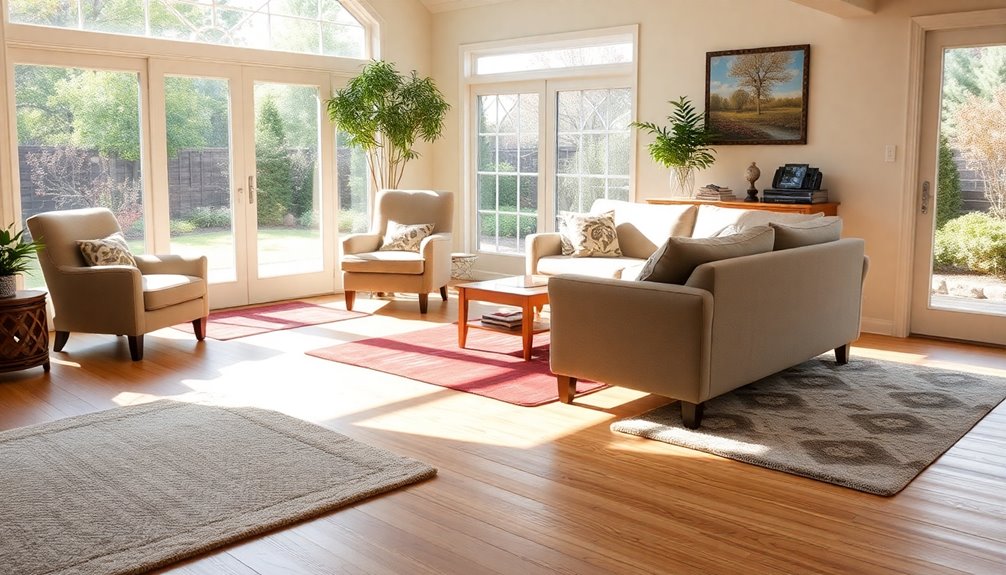
A slip-resistant floor is essential for preventing falls, especially in high-risk areas like kitchens and bathrooms where moisture can create dangerous conditions.
To make your home more accessible, consider these tips for choosing slip-resistant floors:
- Opt for appropriate materials such as textured vinyl or rubber flooring.
- Guarantee flooring is seamless to avoid tripping hazards.
- Keep smooth thresholds in doorways less than 2 inches wide for easy movement.
- Regularly inspect slip-resistant floors for wear and tear to maintain safety.
- Additionally, monitor smoke levels from wood pellet stoves can help in maintaining a safe and comfortable home environment.
Smart Light System
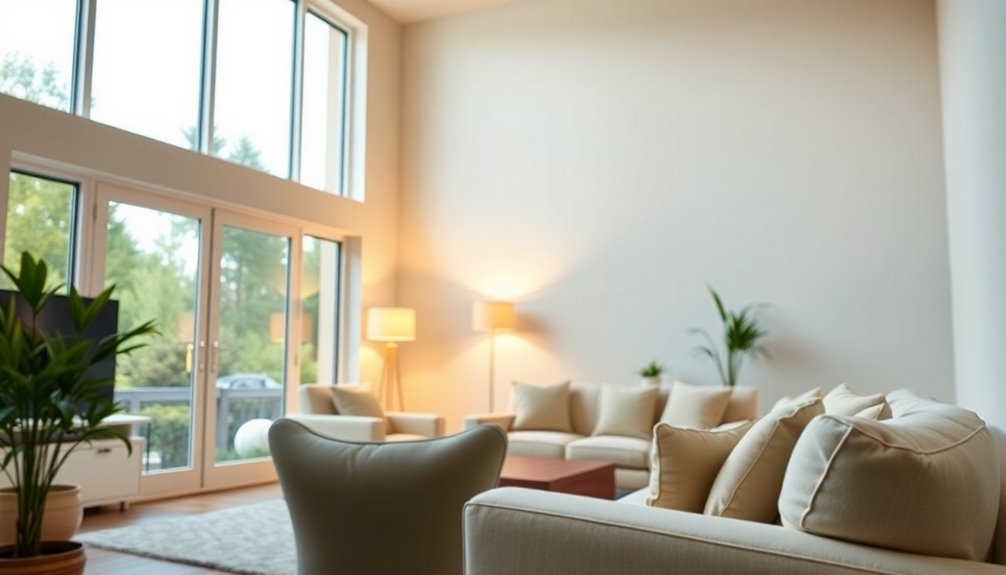
While slip-resistant floors are essential for safety, a smart light system can further enhance accessibility in senior homes.
By replacing traditional switches with sound-activated or motion-activated sensors, you'll find it easier to control the lighting without fumbling in the dark. This system allows you to configure light brightness to suit your preferences, improving comfort and safety.
Imagine entering a room and having the lights automatically turn on, then off when you leave—this not only conserves energy but also reduces effort. Some smart lighting even adjusts based on the time of day, ensuring ideal visibility. Additionally, maintaining a clean air environment is crucial as it complements the benefits of a smart lighting system by promoting overall well-being.
Making Your Kitchen Accessible
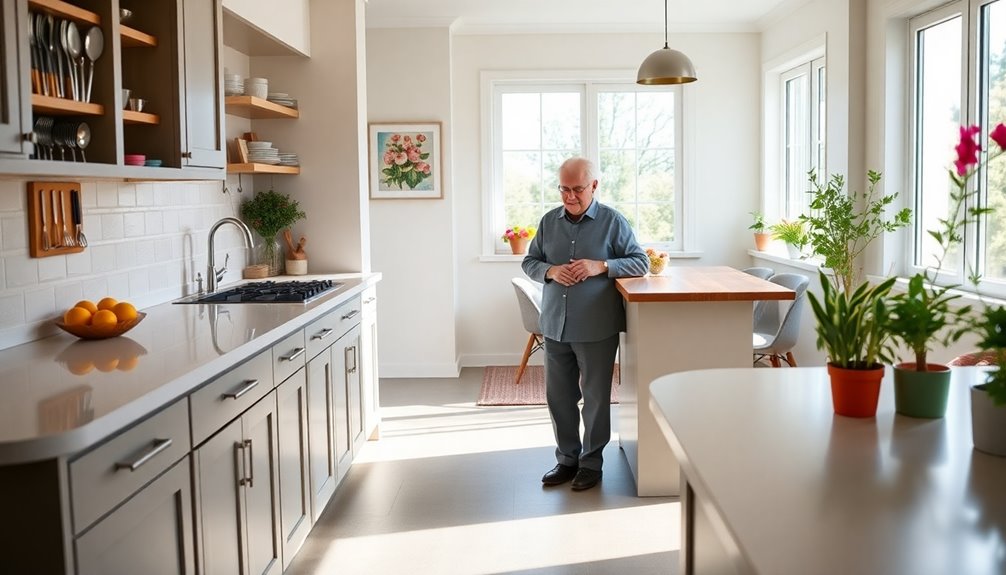
Creating an accessible kitchen involves thoughtful design choices that cater to all users, especially seniors and individuals with mobility challenges.
Here are some Universal Design tips for making your kitchen accessible:
- Implement multi-tiered counters for ease of use, allowing wheelchair users to comfortably reach different surfaces.
- Store frequently used items like spices and silverware in lower-level drawers for easy access without reaching.
- Guarantee at least 30-by-48-inch clearance around appliances and furniture for smooth wheelchair maneuverability.
- Use lever-style handles on cabinets and drawers instead of knobs to simplify operation for those with limited hand strength.
Grab Bars and Railings
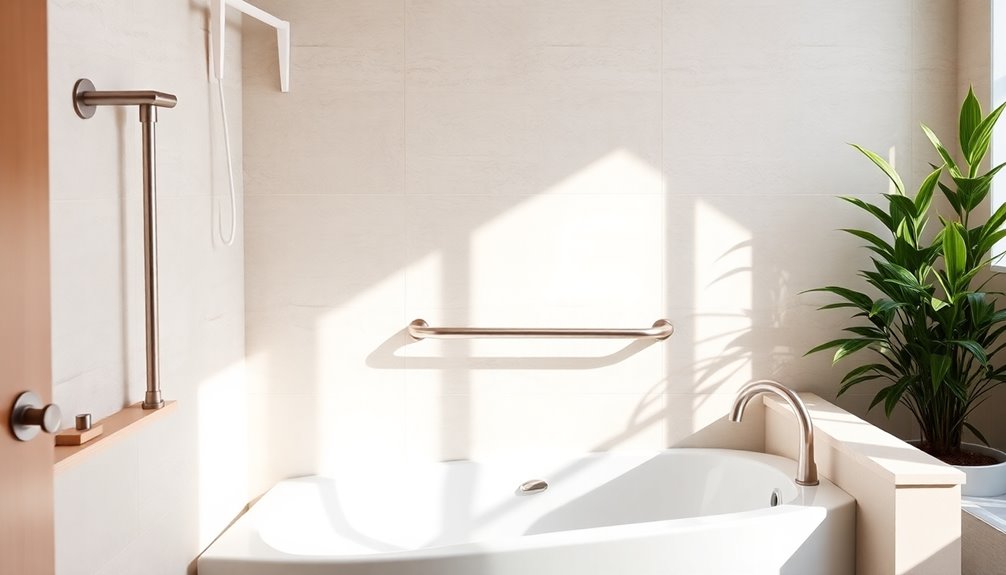
Installing grab bars and railings is essential for enhancing safety and accessibility in senior homes.
You should install grab bars that are at least 42 inches long on side walls near toilets, showers, and bathtubs to provide necessary support and stability.
Space grab bars no more than 12 inches apart, starting from the back wall, to guarantee they're easily reachable.
Position them 33 to 35 inches above the ground for ideal accessibility.
For staircases, handrails on both sides should be installed at a height of 34 to 38 inches, aiding safe navigation.
Consider adding extra grab bars in kitchens, bathrooms, and bedrooms to further enhance safety and independence in everyday activities.
Additionally, a clean and organized environment can enhance mental well-being, further supporting the overall quality of life for seniors.
Your home can become a safer haven!
Adding a Wheelchair Ramp
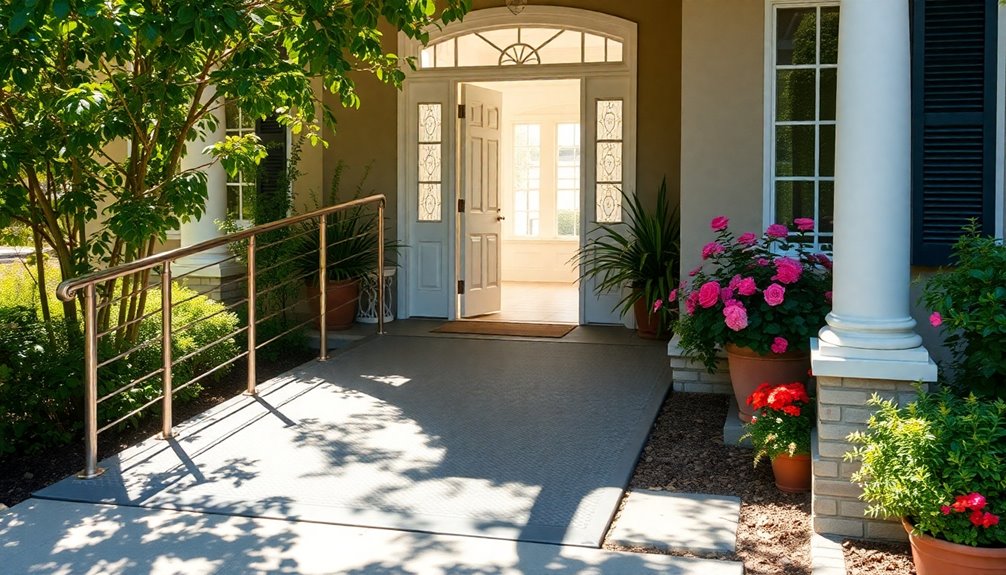
Adding a wheelchair ramp can greatly improve accessibility for seniors and individuals with mobility challenges.
Installing a ramp at your front porch makes getting in and out of the home much easier. To guarantee safety, be sure your ramps comply with safety standards, like a 1:12 slope for residential use.
Consider these important factors for your wheelchair ramp:
- Cost: Expect to spend between $1,061 and $3,406, depending on materials and design.
- Integration: Incorporate ramps into decks or patios for outdoor accessibility.
- Maintenance: Regularly check for wear and guarantee surfaces are slip-resistant.
- Safety: Adhere strictly to safety standards to prevent accidents.
Frequently Asked Questions
What Are the 7 Principles of Universal Design?
The 7 principles of universal design create inclusive environments for everyone.
First, Equitable Use guarantees fairness for all users.
Then, Flexibility in Use accommodates different preferences and abilities.
Simple and Intuitive Use makes spaces easy to navigate.
Perceptible Information provides essential details effectively, while Tolerance for Error minimizes risks.
Low Physical Effort focuses on comfort, and Size and Space for Approach and Use allow accessibility for various body sizes and mobility levels.
How to Design a House for Seniors?
When you design a house for seniors, focus on accessibility and safety. Create no-step entryways and wide doorways to make movement easier.
In the bathrooms, include curbless showers and grab bars for support. Use lever-style door handles and easy-grip pulls to reduce strain.
Guarantee living areas have sufficient clearance for wheelchairs, and consider automating lighting with motion sensors for nighttime safety.
These elements will help seniors feel more comfortable and independent in their homes.
What Is the Most Desirable Home Design for Aging in Place?
When it comes to designing a home for aging in place, you want to hit the nail on the head.
Think about features that enhance accessibility, like no-step entries and wider doorways. Curbless showers and slip-resistant flooring can greatly reduce fall risks.
Use lever-style door handles and easy-to-grasp cabinet pulls to promote independence.
Also, smart lighting systems can make traversing your home safer and easier, day or night.
What Is a Universal Design for Aging in Place?
Universal design for aging in place means creating a home that's accessible and safe for everyone, regardless of age or ability.
You'll want features like no-step entries, wide doorways, and slip-resistant floors to minimize fall risks.
This approach not only enhances your comfort and independence but also makes your home more valuable.
Conclusion
Incorporating these universal design tips can transform a senior home into a space that's safe and welcoming. Did you know that about 75% of seniors want to age in place? By making simple adjustments like adding grab bars or a wheelchair ramp, you can help create an environment that supports independence and comfort. Embrace these changes, and you'll not only enhance safety but also enrich the quality of life for your loved ones.
